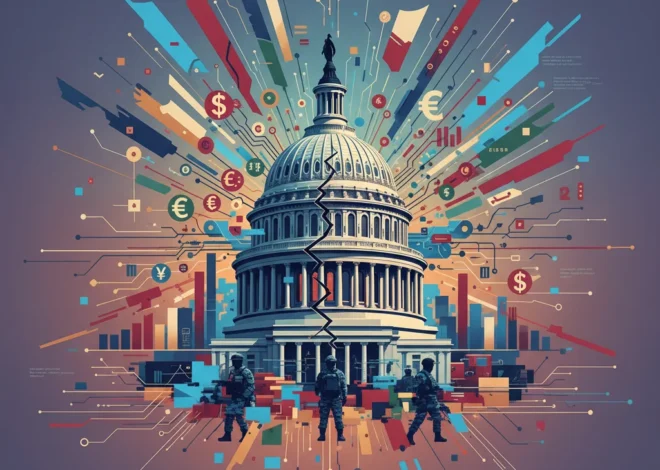
Budget Alarms, AI Ambitions, and Border Tensions: Decoding the New Global Economic Chessboard
In today’s interconnected world, it’s easy to view events through a narrow lens: a domestic policy debate here, a technological rivalry there, a geopolitical shift somewhere else. Yet, the reality is far more complex and intertwined. The threads of national economic strategy, cutting-edge tech development, and international security are weaving a new, intricate tapestry that every investor, business leader, and finance professional must understand. A recent dispatch from the Financial Times encapsulates this perfectly, highlighting three seemingly disparate events: UK business leaders expressing concern over the Labour party’s budget proposals, the strategic training of Chinese AI models on foreign soil, and France’s contemplation of expanded military service.
Taken individually, each is a significant headline. But viewed together, they reveal the fault lines and power plays defining the modern global economy. This isn’t just a collection of news items; it’s a real-time case study in how domestic fiscal policy, the race for technological supremacy, and old-fashioned security concerns are converging to create both unprecedented risks and unique opportunities in the world of finance and investing.
The UK’s Economic Tightrope: Business Leaders Raise Red Flags
All eyes in the UK are on the upcoming general election, with the Labour party, led by Keir Starmer and Shadow Chancellor Rachel Reeves, holding a significant lead in the polls. As a government-in-waiting, their economic platform is under intense scrutiny. Reeves has positioned herself as a paragon of fiscal responsibility, promising iron-clad fiscal rules and a stable environment for business. However, despite these assurances, a sense of unease is percolating through the British business community.
Business leaders have begun to voice concerns, or “chide” the proposals, as the Financial Times reports. The core of the apprehension isn’t necessarily about a radical departure from orthodoxy, but rather a perceived lack of clarity and a potential for policies that could stifle growth. Key concerns include:
- Taxation Ambiguity: While Labour has ruled out increases in income tax, national insurance, and VAT, questions linger about other potential levers, such as capital gains tax or corporation tax adjustments. For long-term investing and capital allocation, this uncertainty is a significant headwind.
- Regulatory Burden: Proposed changes to labour laws, while aimed at improving workers’ rights, have some business leaders worried about increased operational costs and reduced flexibility, which could impact the UK’s competitiveness.
- The Growth Question: Reeves’ plan hinges on kickstarting Britain’s sluggish growth. Yet, critics argue the specific, high-impact policies to achieve this remain vague. Without a clear, pro-enterprise agenda, the fear is that fiscal consolidation will take precedence over pro-growth reforms, potentially leading to a stagnant economy.
This dialogue is crucial for the stock market and for international investors. The UK’s ability to attract capital and foster innovation—particularly in high-growth sectors like financial technology—depends on a predictable and supportive policy environment. The current skepticism from the business community signals that Labour still has work to do to win the full confidence of the market. The outcome will have profound implications for the future of British banking and finance.
The Billion Question: Who Audits OpenAI, and Why Does It Matter to Your Portfolio?
The Great Tech Decoupling: China’s AI Goes Abroad
Shifting our focus from domestic policy to global technology, another critical development is the trend of Chinese companies training their advanced AI models overseas. This is not a matter of simple logistics; it’s a strategic maneuver in the escalating tech cold war between the US and China. The primary driver is access to the one resource that fuels modern AI: high-performance computing chips, specifically those designed by companies like Nvidia.
The US has imposed stringent export controls, aiming to kneecap China’s progress in developing cutting-edge AI. To circumvent these restrictions, Chinese tech giants are leveraging a globalized world. By partnering with data centers and cloud providers in other regions, they can legally access the processing power needed to train large language models (LLMs) that compete with the likes of OpenAI’s GPT-4 and Google’s Gemini. This has several profound implications for the fintech and tech sectors:
- A Globalized Arms Race: It demonstrates that technological containment is incredibly difficult in a world with global supply chains and cloud infrastructure. The AI race cannot be confined by national borders.
- Investment and Infrastructure: This trend creates a boom for data centers and cloud service providers in neutral or friendly jurisdictions. It’s a geopolitical arbitrage play, where capital flows to regions that can bridge the gap between Chinese demand and Western technology supply. This is a new and complex variable for those involved in tech trading and investment.
- The Future of Data: Training these models requires vast datasets. The act of training them overseas raises significant questions about data sovereignty, privacy, and the international governance of AI, a field where blockchain technology is often cited as a potential solution for provenance and security.
This strategic move by Chinese firms highlights the immense economic and geopolitical stakes of the AI revolution. It’s a high-stakes game of chess where the world’s technological future is the prize, and the moves are being financed by a global flow of capital seeking to navigate a fractured geopolitical landscape (source).
Echoes of the Past: National Service and the Economics of Security
The final piece of the puzzle comes from continental Europe, where France is debating an expansion of its military service. This move, echoing similar discussions across NATO countries, is a direct response to heightened geopolitical tensions, most notably the war in Ukraine. While the immediate context is military preparedness, the economic ramifications are vast and cannot be ignored by anyone studying international economics.
Reintroducing or expanding national service is a decision with significant fiscal and labor market consequences. It represents a fundamental shift in state priorities, reallocating resources from the civilian economy to national defense. Below is a breakdown of the potential economic impacts.
| Potential Economic Benefits | Potential Economic Drawbacks |
|---|---|
| Skills and Training: Provides young people with discipline, technical skills, and vocational training that could be transferable to the civilian workforce. | Labor Market Disruption: Removes a significant cohort of young people from the workforce or higher education for a period, potentially creating labor shortages and delaying career progression. |
| Infrastructure Investment: Requires government spending on bases, equipment, and logistics, which can stimulate certain sectors of the economy. | Fiscal Burden: A costly endeavor that requires significant public expenditure, potentially leading to higher taxes, increased borrowing, or cuts to other public services like healthcare and education. |
| Social Cohesion: Aims to foster a sense of national unity and civic duty, which can have intangible but positive long-term economic benefits. | Opportunity Cost: The capital and labor dedicated to military service could have been used in more productive, growth-oriented sectors of the private economy. |
For investors, a move like this is a powerful signal. It indicates that a government perceives a high level of systemic risk, which can dampen investor confidence in the region. According to the FT’s coverage of global affairs, such security-focused policies force a repricing of risk for all European assets. It also impacts sectors directly, boosting defense and cybersecurity stocks while potentially harming consumer-facing industries that rely on a stable and predictable environment.
Geopolitical Chess at COP30: How Brazil's Climate Diplomacy is Reshaping Global Finance
Connecting the Dots: A Unified Framework for the Modern Investor
How do these three disparate stories—a UK budget debate, a Chinese AI strategy, and a French military plan—connect into a coherent worldview for those in finance? The common thread is the erosion of the post-Cold War consensus of stable globalization. We are entering a new era defined by three key themes:
- The Primacy of Domestic Politics: National economic policies, like the UK’s upcoming budget, are becoming more critical than ever. As countries look inward to solve issues of inequality and slow growth, investors must pay closer attention to the nuances of local politics, as they can no longer rely on a uniform global trend.
- Technology as a Geopolitical Weapon: The AI race shows that financial technology and innovation are no longer just about market competition; they are central to the balance of global power. Investment in tech now requires a deep understanding of sanctions, export controls, and national security priorities.
- The Return of Hard Power: The discussion around military service in France is a reminder that geopolitical risk is back at the forefront. The “peace dividend” that fueled market growth for decades is shrinking, and markets must now price in a higher probability of conflict and instability.
For the savvy investor or business leader, navigating this landscape requires a new playbook. It demands a holistic approach that integrates analysis of economics, technology, and geopolitics. It means diversifying not just across asset classes but across geopolitical blocs. And it requires leveraging advanced tools, from AI-driven market analysis to blockchain-based supply chain verification, to manage risk in an increasingly uncertain world.
The Epstein Files Unsealed: A Black Swan Event for Wall Street and the Global Economy?
Conclusion: Thriving in an Age of Complexity
The world is not getting simpler. The challenges highlighted—from winning business confidence in the UK to navigating the US-China tech rivalry and confronting renewed security threats in Europe—are not isolated issues. They are symptoms of a global system in transition. The old rules of investing and finance, which assumed a steady march toward greater integration, are being rewritten in real-time. Success in this new environment will not come from focusing on a single piece of the puzzle, but from understanding how they all fit together on a complex and ever-shifting global chessboard.


